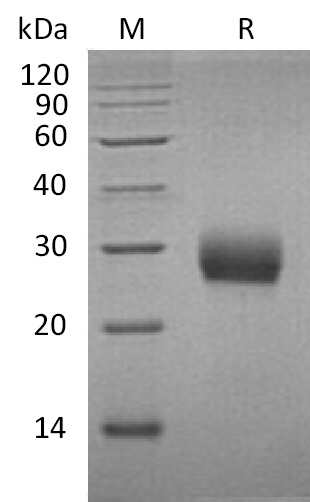- 全部删除
 您的购物车当前为空
您的购物车当前为空
RANK/TNFRSF11A Protein, Mouse, Recombinant (His)
Receptor activator of NF-κB(RANK,TNFRSF11A) belongs to one member of tumor necrosis factor receptor family.It is a receptor for TNFSF11/RANKL/TRANCE/OPGL. This gene encodes a type 1 membrane protein with a 30 amino acids (aa) signal peptide, 184 aa extracellular region , a 20 aa transmembrane domain and a 391 aa cytoplasmic region. Human and murine RANK share 81% aa identity in their extracellular domains. RANK is ubiquitous highly expressed in trabecular bone, thymus, small intestine, lung, brain and kidney, but weakly expressed in spleen and bone marrow. After binding its ligand RANKL, RANK can activate signaling pathways such as NF-κB, JNK, ERK, p38, and Akt/PKB, through TRAF protein phosphorylation. RANK/TNFRSF11A signaling is largely considered to be growth promoting and apoptosis reducing such as the effects observed in osteoclasts. RANK/TNFRSF11A was also found to be involved in the regulation of interactions between T-cells and dendritic cells.

RANK/TNFRSF11A Protein, Mouse, Recombinant (His)
| 规格 | 价格 | 库存 | 数量 |
|---|---|---|---|
| 10 μg | ¥ 740 | 5日内发货 | |
| 50 μg | ¥ 1,970 | 5日内发货 | |
| 500 μg | ¥ 12,100 | 5日内发货 | |
| 1 mg | ¥ 17,400 | 5日内发货 |
产品信息
| 生物活性 | Activity has not been tested. It is theoretically active, but we cannot guarantee it. If you require protein activity, we recommend choosing the eukaryotic expression version first. |
| 产品描述 | Receptor activator of NF-κB(RANK,TNFRSF11A) belongs to one member of tumor necrosis factor receptor family.It is a receptor for TNFSF11/RANKL/TRANCE/OPGL. This gene encodes a type 1 membrane protein with a 30 amino acids (aa) signal peptide, 184 aa extracellular region , a 20 aa transmembrane domain and a 391 aa cytoplasmic region. Human and murine RANK share 81% aa identity in their extracellular domains. RANK is ubiquitous highly expressed in trabecular bone, thymus, small intestine, lung, brain and kidney, but weakly expressed in spleen and bone marrow. After binding its ligand RANKL, RANK can activate signaling pathways such as NF-κB, JNK, ERK, p38, and Akt/PKB, through TRAF protein phosphorylation. RANK/TNFRSF11A signaling is largely considered to be growth promoting and apoptosis reducing such as the effects observed in osteoclasts. RANK/TNFRSF11A was also found to be involved in the regulation of interactions between T-cells and dendritic cells. |
| 种属 | Mouse |
| 表达系统 | HEK293 Cells |
| 标签 | C-6xHis |
| 蛋白编号 | O35305 |
| 别名 | tumor necrosis factor receptor superfamily member 11A,TRANCER,TRANCE receptor,TRANCE R,TNFRSF11A,Receptor activator of NF-KB,Osteoclast differentiation factor receptor,ODFR,NFKB activator,CD265 antigen,CD265 |
| 氨基酸序列 | Val31-Ser214 |
| 蛋白构建 | Val31-Ser214 |
| 蛋白纯度 | Greater than 95% as determined by reducing SDS-PAGE. (QC verified)  |
| 分子量 | 26-30 KDa (reducing condition) |
| 内毒素 | < 0.1 ng/µg (1 EU/µg) as determined by LAL test. |
| 缓冲液 | Lyophilized from a solution filtered through a 0.22 μm filter, containing PBS, pH 7.4. |
| 复溶方法 | Reconstitute the lyophilized protein in distilled water. The product concentration should not be less than 100 μg/ml. Before opening, centrifuge the tube to collect powder at the bottom. After adding the reconstitution buffer, avoid vortexing or pipetting for mixing. |
| 存储 | Lyophilized powders can be stably stored for over 12 months, while liquid products can be stored for 6-12 months at -80°C. For reconstituted protein solutions, the solution can be stored at -20°C to -80°C for at least 3 months. Please avoid multiple freeze-thaw cycles and store products in aliquots. |
| 运输方式 | In general, Lyophilized powders are shipping with blue ice. Solutions are shipping with dry ice. |
| 研究背景 | Receptor activator of NF-κB(RANK,TNFRSF11A) belongs to one member of tumor necrosis factor receptor family.It is a receptor for TNFSF11/RANKL/TRANCE/OPGL. This gene encodes a type 1 membrane protein with a 30 amino acids (aa) signal peptide, 184 aa extracellular region , a 20 aa transmembrane domain and a 391 aa cytoplasmic region. Human and murine RANK share 81% aa identity in their extracellular domains. RANK is ubiquitous highly expressed in trabecular bone, thymus, small intestine, lung, brain and kidney, but weakly expressed in spleen and bone marrow. After binding its ligand RANKL, RANK can activate signaling pathways such as NF-κB, JNK, ERK, p38, and Akt/PKB, through TRAF protein phosphorylation. RANK/TNFRSF11A signaling is largely considered to be growth promoting and apoptosis reducing such as the effects observed in osteoclasts. RANK/TNFRSF11A was also found to be involved in the regulation of interactions between T-cells and dendritic cells. |




